The Desert Botanical Garden Phoenix is a treasure trove of natural beauty, a place where visitors can immerse themselves in the unique and fascinating ecosystem of the Sonoran Desert. Located in Papago Park, just a few miles east of downtown Phoenix and adjacent to the Arcadia neighborhood, the garden is surrounded by stunning natural beauty and is easily accessible from many areas of the city With its wide variety of cacti, succulents, and other desert plants, the garden offers a glimpse into the remarkable adaptations and survival strategies that have allowed life to thrive in this challenging environment.
If you’re planning a trip to Phoenix, be sure to put the Desert Botanical Garden on your itinerary. In this article, we’ll explore the history, plant life, and nearby attractions that make this one of the most popular destinations in the city.
A Brief History of the Desert Botanical Garden Phoenix
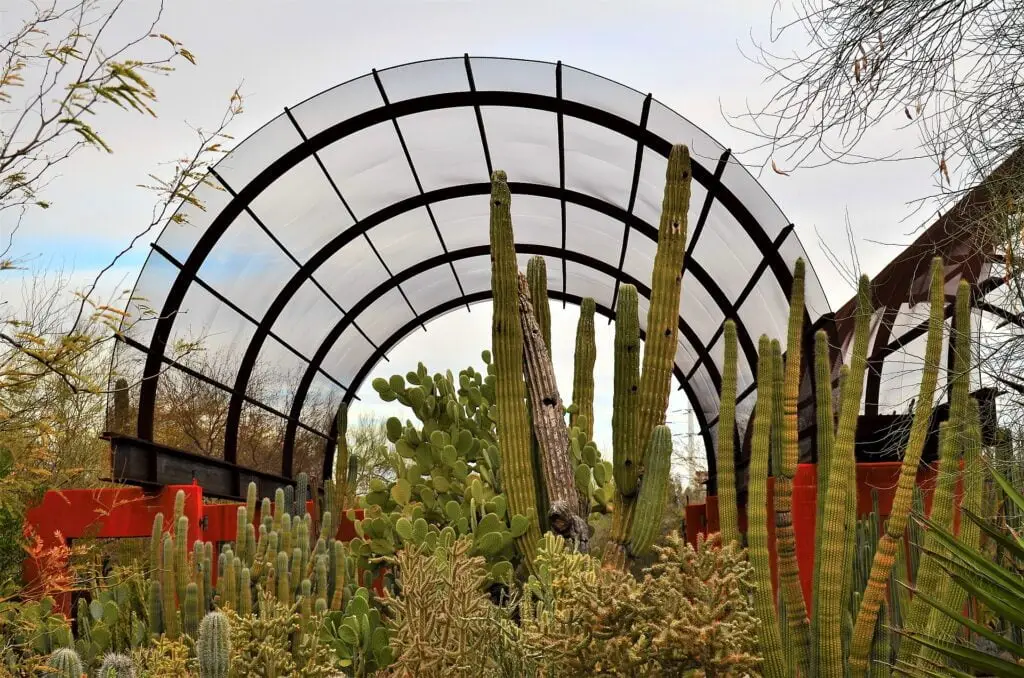
The Desert Botanical Garden Phoenix has a rich and fascinating history that spans over 80 years. Here are a few highlights:
- The garden was founded in 1939 by a group of local plant enthusiasts who were passionate about preserving and showcasing the unique flora of the Sonoran Desert.
- In the early years, the garden focused on collecting and studying desert plants from around the world, with a particular emphasis on those found in Arizona and the surrounding region.
- Over time, the garden expanded its mission to include education, conservation, and research, becoming a leading center for the study and promotion of desert plants and ecosystems.
- Today, the Desert Botanical Garden Phoenix is one of the most popular attractions in the city, drawing visitors from around the world who are eager to explore its many wonders.
- As the Desert Botanical Garden Phoenix continued to grow in popularity, it underwent several expansions and renovations. In the 1960s, a new visitor center was built, and the garden’s trail system was expanded to allow for more exploration of its diverse landscapes.
- In 1989, the garden opened the Marshall Butterfly Pavilion, which showcases hundreds of live butterflies from around the world in a unique and immersive exhibit.
- More recently, the garden has undertaken ambitious conservation efforts, partnering with other organizations to protect and restore threatened species and habitats in the region.
- Despite its evolution over the years, the Desert Botanical Garden Phoenix remains true to its founding mission of celebrating the unique beauty and diversity of the Sonoran Desert. With its stunning plant collections, engaging educational programs, and ongoing conservation work, it continues to inspire and delight visitors of all ages and backgrounds.
Plant Life at the Desert Botanical Garden Phoenix
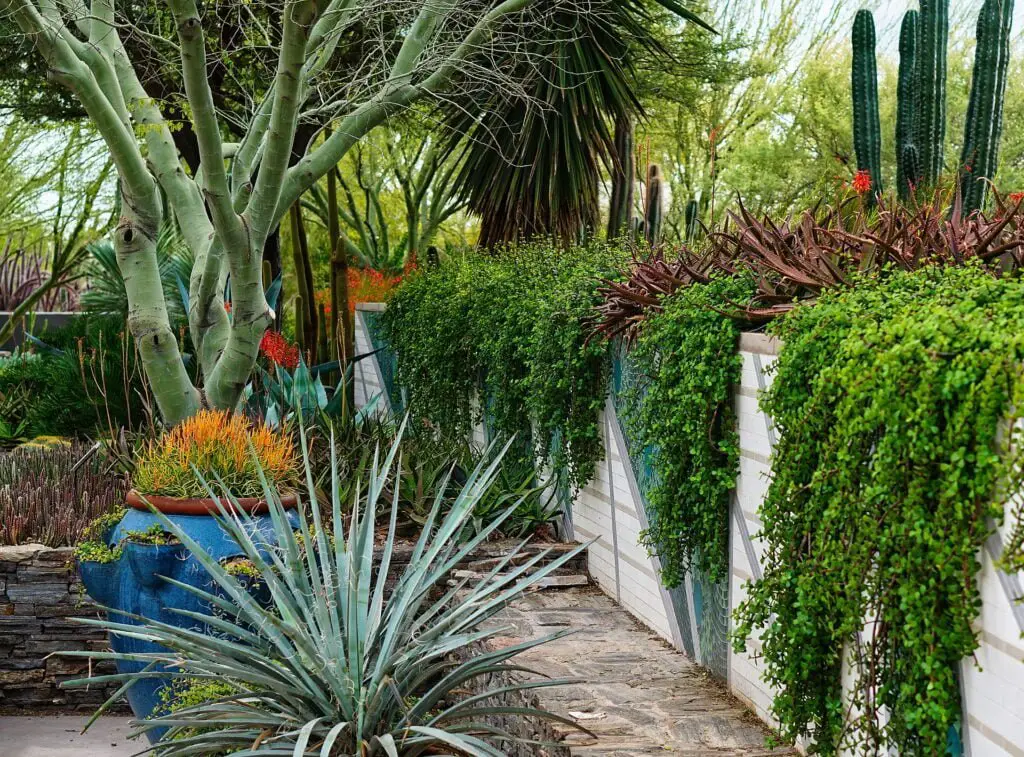
The plant life at the Desert Botanical Garden Phoenix is diverse, fascinating, and often surprising. Here are a few highlights:
- The garden is home to over 50,000 plants from 4,000 species, including a wide variety of cacti, succulents, and other desert-adapted plants.
- Some of the most famous plants in the garden are the saguaro cacti, which can grow up to 60 feet tall and live for over 200 years.
- Other notable plants include the agave, which is used to make tequila, and the ocotillo, which is known for its striking red flowers.
- The garden also features a butterfly exhibit, where visitors can see dozens of different species of butterflies up close.
Visitors to the Desert Botanical Garden Phoenix can find inspiration for their own home gardens or backyards by exploring the diverse plant life on display. Here are a few examples of desert-adapted plants that can thrive in a home garden or backyard:
- Desert Marigold: These bright yellow flowers are a great addition to any garden and are known for attracting butterflies and bees.
- Texas Sage: Also known as “cenizo,” this shrub produces beautiful purple flowers and is drought-tolerant.
- Red Yucca: Despite its name, this plant is not actually a yucca but rather a type of agave. It produces tall spikes of red or pink flowers and can be a great addition to a xeriscape garden.
- Desert Willow: This small tree produces beautiful pink or purple flowers and is a great option for providing shade in a backyard.
- Fairy Duster – a shrub with delicate pink or red flowers that attract hummingbirds and butterflies.
- Desert Spoon – a succulent plant with a unique, spoon-shaped leaf structure that adds visual interest to any garden.
- Oregano – an herb that is easy to grow and can be used fresh or dried in cooking.
By incorporating desert-adapted plants into their gardens, homeowners can create a beautiful and sustainable outdoor space while conserving water and supporting local ecosystems.
Points of interest inside the Desert Botanical Garden Phoenix
The Desert Botanical Garden Phoenix is a true oasis in the desert, with its stunning natural beauty and impressive collection of plants and exhibits. But the Garden also offers much more than just a walk through the desert landscape. With a variety of attractions and points of interest, visitors can explore and learn about the Sonoran Desert in a variety of ways. In this section, we’ll take a closer look at some of the must-see points of interest inside the Garden, including the Webster Auditorium and the Weisz Family Plaza.
Webster Auditorium
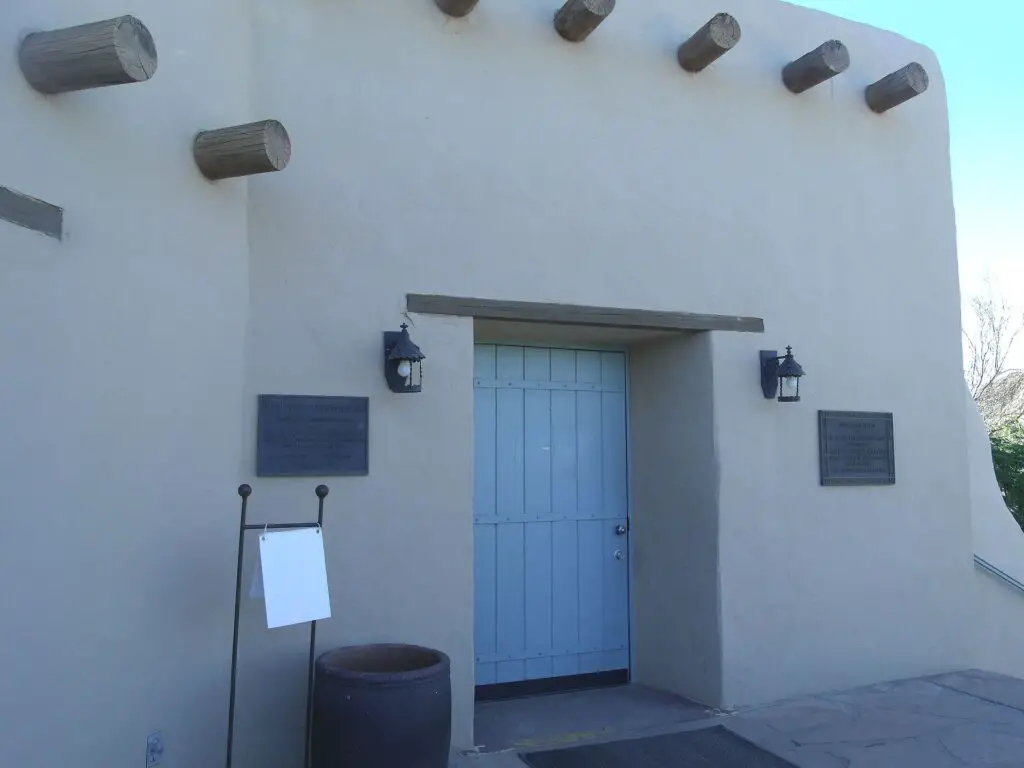
The Webster Auditorium is a stunning venue located within the Desert Botanical Garden Phoenix. Named after Nina Mason Pulliam, this state-of-the-art facility can accommodate up to 450 guests and is a popular destination for concerts, lectures, and other special events.
With its sleek and modern design, the Webster Auditorium provides a stunning backdrop for any occasion. The space features cutting-edge audiovisual technology, including a 20-foot-high screen and state-of-the-art sound system, making it an ideal venue for presentations, performances, and films.
In addition to its impressive technical capabilities, the Webster Auditorium offers a unique and intimate setting for special events. Its location within the Garden provides guests with breathtaking views of the surrounding desert landscape, and its flexible seating arrangement allows for a variety of event styles and sizes.
Whether you’re attending a concert, lecture, or special event, the Webster Auditorium at the Desert Botanical Garden Phoenix offers an unforgettable experience in a truly exceptional setting.
Weisz Family Plaza

The Weisz Family Plaza is a stunning outdoor space at the Desert Botanical Garden Phoenix that offers breathtaking views of the surrounding desert landscape. This open-air amphitheater is a popular venue for concerts, performances, and other special events.
Designed by Christy Ten Eyck, the plaza features a terraced seating area that can accommodate up to 500 guests. The terraces are made of local sandstone and are surrounded by native plants, including ocotillo, palo verde, and saguaro cactus.
The focal point of the plaza is a large circular stage that is surrounded by a reflecting pool. The stage is made of rusted steel and features a natural acoustic shell that provides excellent sound quality for performances.
The Weisz Family Plaza is a versatile space that can be used for a variety of events, from small concerts to large-scale productions. It’s stunning design and natural setting make it a popular choice for weddings, corporate events, and other special occasions.
In addition to its use as an event space, the Weisz Family Plaza also serves as a gathering place for visitors to the Garden. Its peaceful setting and sweeping views of the desert make it a perfect spot to relax and take in the natural beauty of the area.
Nearby Attractions and Restaurants
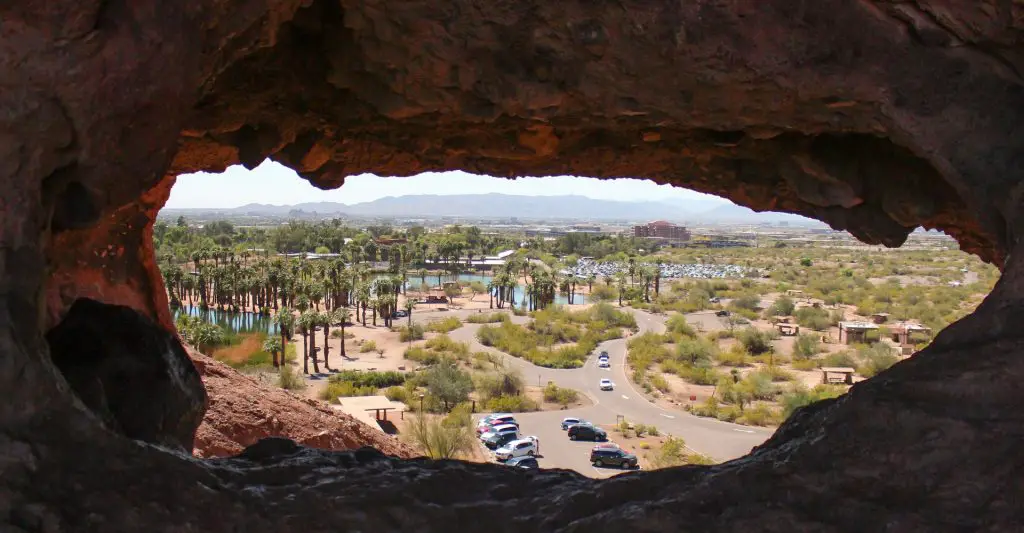
There are plenty of other things to do and see in the area surrounding the Desert Botanical Garden Phoenix. Here are a few suggestions:
- Papago Park: This nearby park features hiking trails, picnic areas, and the iconic Hole in the Rock Formation. Visitors can enjoy stunning views of the city and the surrounding desert landscape.
- Phoenix Zoo: Just a short drive from the Garden, the Phoenix Zoo is home to more than 3,000 animals from around the world. Visitors can see everything from giraffes and lions to meerkats and otters.
- Gertrude’s Restaurant: Located inside the Garden, Gertrude’s offers a farm-to-table dining experience with a focus on seasonal and locally sourced ingredients. Visitors can enjoy brunch, lunch, or dinner while taking in the stunning views of the Garden.
- O.H.S.O. Brewery: This local brewery and gastropub is a great spot for a post-Garden beer or meal. Visitors can enjoy craft beers and pub fare on the dog-friendly patio.
If you have some extra time in Phoenix after exploring the Desert Botanical Garden, there are plenty of other nearby attractions to check out. One option is the Phoenix Zoo, which is just a short drive from the Garden. The zoo is home to more than 3,000 animals from around the world, including giraffes, lions, meerkats, and otters.
If you’re feeling hungry, there are several great dining options in the area as well. Gertrude’s Restaurant, located inside the Garden, offers a farm-to-table dining experience with a focus on seasonal and locally sourced ingredients. Visitors can enjoy brunch, lunch, or dinner while taking in the stunning views of the Garden.
And if you’re looking to bring home some desert plants to plant in your own home garden, be sure to stop by the Garden’s gift shop before you go!
Plants and Exhibits at the Desert Botanical Garden Phoenix

The Desert Botanical Garden Phoenix has a diverse collection of plants and exhibits that showcase the beauty and resilience of desert flora. Here are some of the highlights:
- Desert Wildflowers: The Garden has a vibrant display of wildflowers that bloom from February to April. Visitors can marvel at the colors of Mexican gold poppies, desert lupines, and penstemons.
- Sonoran Desert Plants: As a showcase of the Sonoran Desert, the Garden features an impressive collection of cacti, succulents, and other native plants. Some of the highlights include the majestic saguaro cactus, the towering cardon cactus, and the spiny barrel cactus.
- Agave Collection: The Garden is home to a stunning collection of agaves, which are known for their striking architectural forms and dramatic blooms. Visitors can see the giant century plant, the delicate-looking Queen Victoria agave, and the unusual foxtail agave.
- Desert Landscaping: The Garden has several exhibits that demonstrate how desert landscaping can be beautiful and sustainable. Visitors can learn about water-wise gardening, using native plants, and creating habitats for wildlife.
In addition to the above highlights, the Desert Botanical Garden Phoenix also has exhibits that showcase the cultural and historical significance of desert plants. The “Plants & People of the Sonoran Desert” exhibit explores the ways in which indigenous people have used desert plants for food, medicine, and other purposes. The “Desert Discoveries” exhibit features interactive displays that educate visitors about the adaptations that desert plants and animals have developed to survive in their harsh environment.
Another must-see exhibit is the “Butterfly Pavilion,” which houses hundreds of butterflies from around the world. Visitors can walk through the enclosed pavilion and observe the butterflies up close, as well as learn about their life cycle and habitat.
For those interested in gardening and horticulture, the Garden also offers classes and workshops on topics such as plant care, landscaping, and sustainable gardening practices. The Garden’s gift shop is also a great place to find unique gifts, books, and souvenirs related to desert plants and wildlife.
Events and Programs at the Desert Botanical Garden Phoenix
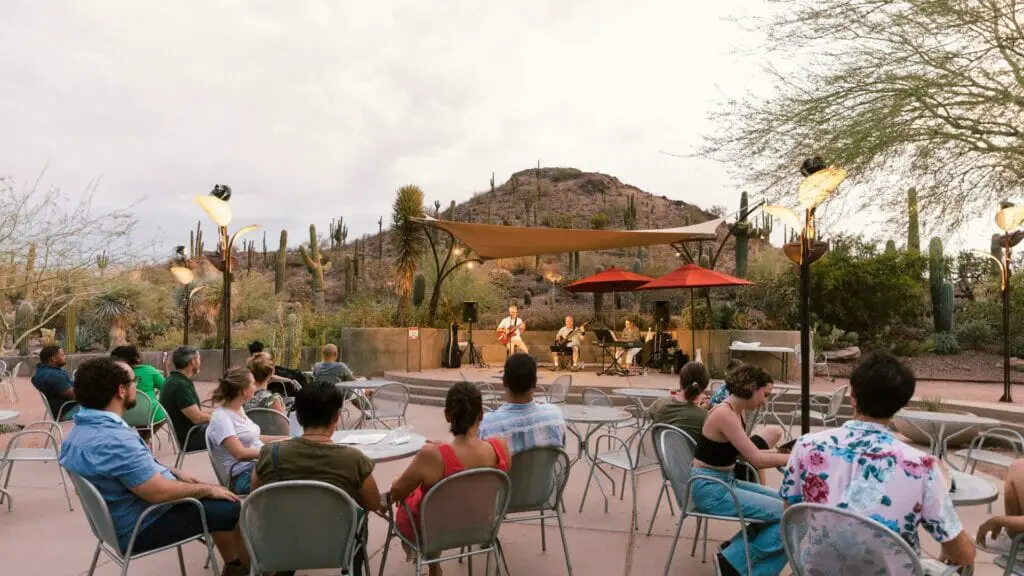
The Desert Botanical Garden Phoenix hosts a variety of events and programs throughout the year, including:
- Music in the Garden: This concert series features live music performances in the Garden’s beautiful outdoor setting. Visitors can bring a blanket and picnic under the stars while enjoying the sounds of jazz, blues, and world music.
- Las Noches de las Luminarias: During the holiday season, the Garden transforms into a magical wonderland of 8,000 hand-lit luminaria bags, twinkling lights, and festive music. Visitors can stroll through the Garden and enjoy the sights and sounds of the season.
- Classes and Workshops: The Garden offers a variety of classes and workshops for all ages and skill levels. Visitors can learn about topics such as photography, gardening, cooking with desert ingredients, and painting.
- Butterfly Exhibit: This seasonal exhibit showcases hundreds of live butterflies from around the world. Visitors can watch the butterflies up close as they flutter among the plants in the enclosed exhibit.
- Guided Tours: The Garden offers guided tours that provide insight into the plants, wildlife, and history of the Sonoran Desert. Visitors can choose from several tour options, including a sunrise tour, a birding tour, and a photography tour.
- Children’s Programs: The Garden has several programs designed specifically for children, including summer camps, storytime in the garden, and a butterfly pavilion. These programs provide a fun and educational experience for young visitors.
- Art Exhibits: The Garden features rotating art exhibits that showcase the beauty and diversity of desert-inspired art. Visitors can view paintings, sculptures, and other works by local and national artists.
In addition to these events and programs, the Garden also hosts private events such as weddings, corporate events, and other special occasions.
Conclusion
The Desert Botanical Garden Phoenix is a must-see attraction for anyone visiting the Phoenix area. With its stunning collection of desert plants, engaging exhibits, and diverse events and programs, the Garden offers something for everyone. Don’t miss the chance to experience the beauty and wonder of the desert at this unique and inspiring destination.
FAQ
Sure, here are some frequently asked questions about the Desert Botanical Garden Phoenix:
1. What are the opening hours of the Desert Botanical Garden Phoenix?
The Garden is open daily from 8:00 a.m. to 8:00 p.m., with last admission at 7:00 p.m.
2. Are pets allowed inside the Garden?
Only service animals are allowed inside the Garden.
3. Is there a fee for parking at the Garden?
No, parking is free for all visitors.
4. Can I bring my own food and drinks to the Garden?
Outside food and drinks are not allowed inside the Garden. However, there are several dining options available onsite.
5. What types of events are held at the Garden?
The Garden hosts a variety of events throughout the year, including concerts, festivals, and workshops. Check the events calendar on the official website for more information.
6. Is the Garden accessible for visitors with disabilities?
Yes, the Garden is fully accessible for visitors with disabilities. Wheelchairs are available for rent at the Admissions Box Office.
7. Can I purchase tickets in advance?
Yes, tickets can be purchased in advance on the official website. It is recommended to purchase tickets in advance to avoid lines at the Admissions Box Office.
8. Are there guided tours available at the Garden?
Yes, guided tours are available at an additional cost. Private tours can also be arranged in advance.
9. Is photography allowed inside the Garden?
Yes, photography is allowed inside the Garden for personal use only. Commercial photography and videography require special permission and fees.
10. What should I wear when visiting the Garden?
It is recommended to wear comfortable walking shoes, a hat, and sunscreen. The Garden is located in the desert, so it can get very hot during the day.







7 thoughts on “Exploring the Wonders of the Desert Botanical Garden Phoenix”